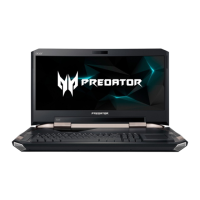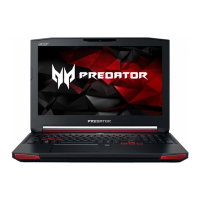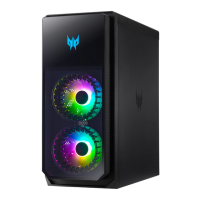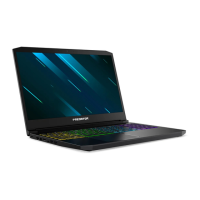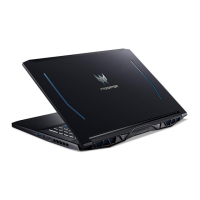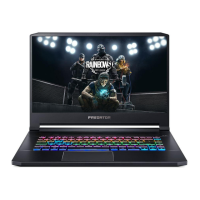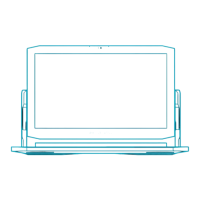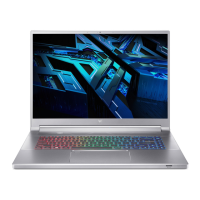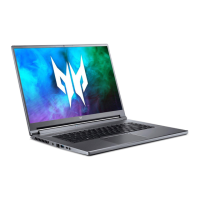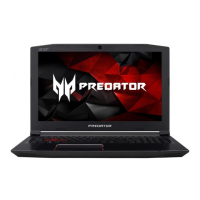Do you have a question about the Acer Predator 17 X and is the answer not in the manual?
Guides for initial setup and basic computer usage.
Essential advice for maintaining and operating the computer safely.
Guidelines for protecting the computer from environmental factors and physical damage.
Recommendations for maintaining the AC adapter for optimal performance and longevity.
Steps for safely cleaning the computer and when to seek professional service.
Identification and description of components visible on the computer screen.
Identification and description of keys, indicators, and features on the keyboard.
Keys that allow customization for specific game settings and profiles.
Description of the touchpad and its basic functions.
Identification of ports and connectors on the left side of the notebook.
Details about USB 3.0 ports, their features, and performance.
Identification of ports and connectors on the right side of the notebook.
Identification of components located on the bottom of the notebook.
Feature that reduces dust accumulation for better component cooling.
Explanation of Caps Lock, Num Lock, and Scroll Lock keys.
Key combinations for controlling computer functions like brightness and volume.
Keys with specific functions related to the Windows operating system.
Explains single, two, and three-finger gestures for touchpad interaction.
Steps to adjust touchpad sensitivity, scrolling, and other behaviors.
Steps to create a system backup for recovery purposes.
Procedure to back up network drivers for future reinstallation.
General explanation of restoring the computer to its default state.
Steps to reset the PC while retaining personal files.
Steps to reset the PC, removing all personal files and settings.
Instructions on how to turn the Bluetooth adapter on and off.
Guide to pairing new devices with the computer's Bluetooth adapter.
Steps to connect to available Wi-Fi networks.
Instructions for connecting to the internet via an Ethernet cable.
Guide to connecting to the internet using a cellular network.
Feature to reduce blue light emissions for eye protection.
Overview of the PredatorSense interface and system status display.
How to configure hotkeys with specific actions in PredatorSense.
Steps to create and manage custom profiles in PredatorSense.
Instructions for recording and saving custom macros in PredatorSense.
How to customize keyboard backlighting zones in PredatorSense.
Configuration options for system behavior and multimedia modes.
Explanation of overclocking capabilities via PredatorSense software.
Details on the "FASTER" overclocking mode for enhanced performance.
Details on the "TURBO" overclocking mode for maximum performance.
How to use a Kensington lock slot to physically secure the computer.
Importance of passwords for system security and different types.
Process and rules for entering passwords for system access and BIOS.
How to configure the boot order in the BIOS settings.
How to set Supervisor and Boot passwords in the BIOS.
Tips and settings for conserving power, including disabling fast startup.
Information about the computer's embedded Lithium battery.
Steps for connecting the AC adapter to charge the battery.
Process for preparing a new battery for optimal use.
Advice on extending battery life and improving recharging efficiency.
How to view the current battery charge status on the taskbar.
Recommended actions when the battery power is low.
Steps to safely disconnect external accessories before moving.
Tips for moving the computer over short distances.
How to prepare the computer for moving or travel.
Items to consider bringing when attending meetings.
List of essential items to bring when traveling.
Guidelines to protect the computer during travel and temperature changes.
Advice for general travel with the computer, including airline requirements.
Specific considerations for international travel with the computer and voltage compatibility.
Step-by-step guide to inserting memory cards into the reader.
Procedure to safely eject memory cards from the reader.
How to connect audio devices and use headphone/microphone ports.
Overview of USB ports, types, and their uses for peripherals and charging.
Connecting multiple 4K displays via Thunderbolt 3 port and adapters.
Explanation of HDMI interface for high-quality digital audio/video connection.
Troubleshooting steps for power-on or boot failure issues.
Troubleshooting steps for issues with audio output from speakers or headphones.
Troubleshooting steps for unresponsive keyboard input.
Troubleshooting steps for printer connectivity and functionality problems.
Information on obtaining technical support, warranty services, and contacting Acer.
Navigation to the Windows Start menu for launching applications.
Method to view a list of all installed applications on the computer.
Steps to properly shut down the computer using the Start menu.
Process for unlocking the computer, requiring a password if set.
Options for customizing the lock screen appearance and notifications.
Steps to configure a slideshow of images for the lock screen.
Steps to adjust the display resolution settings for optimal viewing.
Instructions for setting an alarm using the built-in Alarms application.
How to find and open applications on the computer.
Procedure to pin an application to the Start screen.
Guidance on downloading and installing applications from the Windows Store.
Explanation of Microsoft accounts and their benefits for syncing data.
Procedure to check for and install important Windows updates.
General advice for diagnosing and resolving common computer problems.
Table of common error messages and their recommended corrective actions.
Initial steps for securing your computer against online threats.
Guidance on selecting and connecting with an Internet Service Provider (ISP).
Explanation of Digital Subscriber Line internet connection technology.
Information on cable internet service and its benefits.
Connecting to the internet using cellular networks, often via SIM card.
Overview of Local Area Networks (LAN) and setting up wired/wireless connections.
Benefits and simplicity of setting up wireless LANs for connectivity.
Key components required for setting up a home wireless network.
How to manage Wi-Fi connections and network sharing options.
Using an internet browser to access websites and online content.
Definition and transmission methods of computer viruses and malicious software.
Definition and effects of spyware, including data snooping and pop-up ads.
Definition and examples of malicious software designed to harm computers.
Function and purpose of personal firewall software for network protection.
Tips for creating secure passwords and managing them to protect online accounts.
Advice on safely sharing personal data online and avoiding scams.
Identifying and avoiding phishing emails by checking for red flags.
Caution against clicking unsolicited email links for security reasons.
Avoiding response to emails requesting personal data from legitimate companies.
Identifying and avoiding fake websites that aim to steal personal information.
Recognizing and avoiding deceptive online offers and "free" software.
Importance of regularly checking financial statements to detect unauthorized activity.
Utilizing Windows built-in security features like updates and antivirus.
Signs indicating a computer may be infected by malware or experiencing issues.
| Processor | Intel Core i7-7820HK |
|---|---|
| Operating System | Windows 10 Home |
| Graphics | NVIDIA GeForce GTX 1080 |
| Display | 17.3" FHD (1920 x 1080) IPS / 17.3" UHD (3840 x 2160) IPS |
| RAM | Up to 64GB DDR4 |
| Storage | 512GB SSD + 1TB HDD |
| Battery | 8-cell Li-ion, 6000 mAh |
| Weight | 4.55 kg |
| Dimensions | 423 mm x 321.5 mm |
